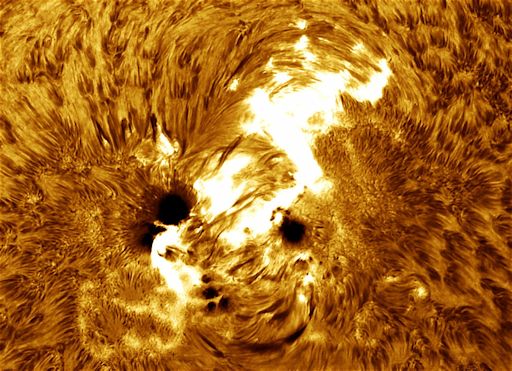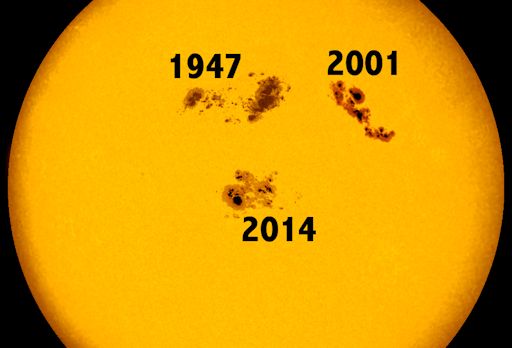Quote:
Originally Posted by Riotpolice

Hey, aren't those sun spots dangerous? I heard if the sun shot out a flare at the earth that it would act like an emp if it was a direct shot.
|
For the most part, no. Earth has a magnetic shield that deflects most of the damage that can be inflicted by CMEs caused by flares from these sunspots. The exception to this is if the sunspots harbour the power to launch a massive flare deep in the X-Class range. Most sunspots never get this close, but the current sunspot group is one of the largest in over 10 years. The last major flare was an X10 fired away in 2003 by the sunspot group posted on the October 22 day, but even then, Earth was able to hold the fort just fine. Latey, flares have not been firing significant CMEs, and the blast ejecta instead has been falling back towards the sun. This means the greatest threat per se are immediate, but brief, radio blackouts on whichever region of the Earth was facing the sun at the time of the flare. I recommend giving the suspicious0bservers video for this week a watch for a graphic explanation of what happens with the flares / blackouts of today.
Daily Suspicious0bserver's Weather Post:
October 25, 2014
What's in the sky tonight?
October 25, 2014
-Giant sunspot AR2192 erupted again on Oct. 24th (21:40 UT), producing a powerful X3-class solar flare. Using a backyard solar telescope, Sergio Castillo of Corona, California, was monitoring the sunspot when it exploded, and he snapped this picture. "This flare was so intense that it almost shorted out my computer! Well ... not really," says Castillo, "but I knew right away that it was an X-class eruption."
A pulse of extreme UV radiation from the flare ionized the upper layers of Earth's atmosphere, causing a brief but strong blackout of HF radio communications over the dayside of Earth. Such blackouts may be noticed by amateur radio operators, aviators, and mariners.
Coronagraph data from the Solar and Heliospheric Observatory (SOHO) suggest that the explosion did not hurl a significant CME toward our planet. (Interestinngly, none of the X-flares from this active region has so far produced a major CME.) As a result, Earth-effects may be limited to the radio blackout.
-Sunspot AR2192, now facing Earth, is the largest sunspot of the current solar cycle. Sprawling across more than 200,000 km of solar terrain, wider than the planet Jupiter, this is the type of sunspot that comes along every 10 years or so. To put AR2192 in context, spaceweather.com reader Hagan Hensley of San Antonio TX placed it beside pictures of two other significant sunspots from the years 2001 and 1947.
"Using Photoshop, I created this composite image of three big sunspots: AR2192 (2014), AR9393 (2001) and the great sunspot of 1947, the largest ever recorded," explains Hensley. "Positions on the solar disk shifted somewhat to avoid overlap."
Spaceweather.com didn't exist in 1947, so we're not sure what happened then. In 2001, however, giant sunspot AR9393 was fully covered by the web site. In March of that year, the sunspot unleashed multiple X-flares, caused radio blackouts and radiation storms, and sparked red auroras seen as far south as Mexico.
-Despite shrinking by ~10% on Oct. 24th, sunspot AR2192 remains the largest and most active sunspot of the current solar cycle. By far. NOAA forecasters estimate an 85% chance of M-class flares and a 45% chance of X-flares on Oct. 25th.

 Astro Picture of the Day:
October 25, 2014
Source:
Astro Picture of the Day:
October 25, 2014
Source:
A New Moon joined giant sunspot group AR 2192 to dim the bright solar disk during Thursday's much anticipated partial solar eclipse. Visible from much of North America, the Moon's broad silhouette is captured in this extreme telephoto snapshot near eclipse maximum from Santa Cruz, California. About the size of Jupiter, the remarkable AR 2192 itself darkens a noticeable fraction of the Sun, near center and below the curved lunar limb. As the sunspot group slowly rotates across the Sun and out of view in the coming days its activity is difficult to forecast. But the timing of solar eclipses is easier to predict. The next will be a total solar eclipse on March 20, 2015.